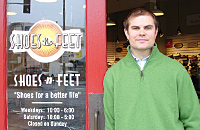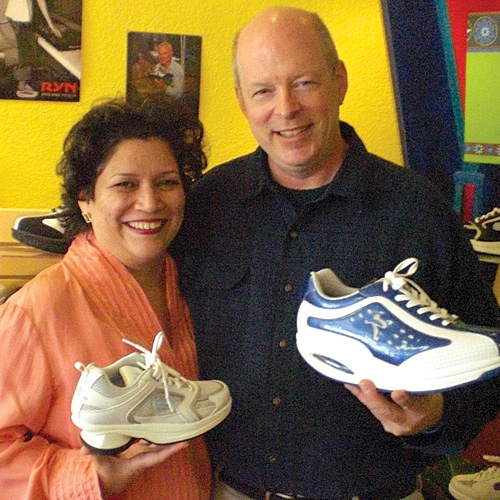
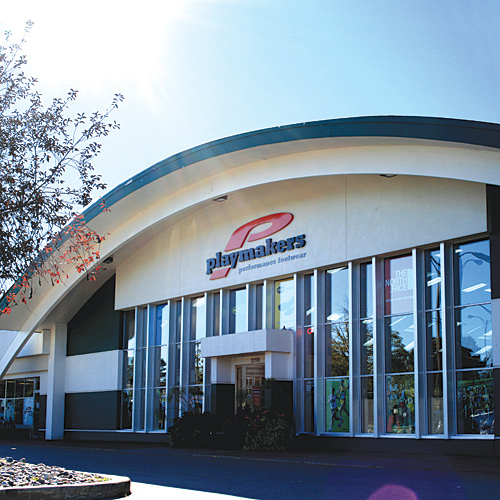
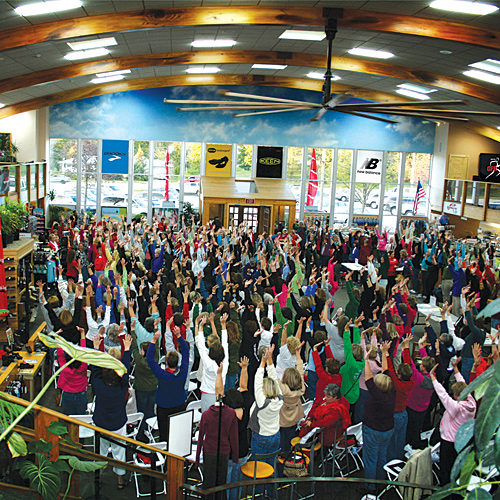
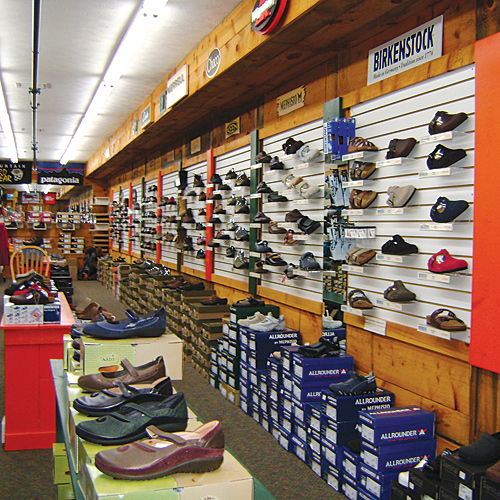
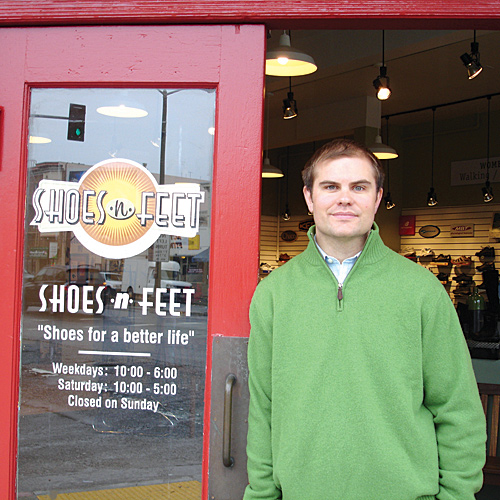
By now it’s clear consumers are buying into the wellness category’s promises of tighter tushies, better alignment and squishier joints. But given the explosion of health-oriented technologies—rocker bottoms, negative-heel angles, minimalist designs, Bosu ball–inspired soles and heel springs, just to name a fewthe segment’s not getting any easier for retailers to navigate. Getting shoppers into the most appropriate wellness shoe requires paying special attention on the sales floor and stocking a variety of products designed to meet their demands.
Here, four retailers—a health-oriented store, a running shop, an outdoor specialist and a head-to-toe wellness store—weigh in on what wellness means to them, and what’s working when it comes to selling shoes of this ilk.
Health First
Promising expert fitting and solutions that will alleviate the wearer’s pain, Shoes-N-Feet sells footwear designed to make movement easy and comfortable. The family-owned company has eight stores in California, Iowa and Washington, and according to Chris Bentvelzen, owner of the San Francisco location, the wellness category fits perfectly into the retailer’s health-encompassing mission.
Whether it’s shoes boasting a rocker sole or alignment capabilities, Shoes-N-Feet sees each pair as a medical tool first and foremost. Bentvelzen and his staff view their product assortment—from New Balance’s TrueBalance line to Ryn and Cogent shoes—as an arsenal of ways to alleviate issues such as plantar fasciitis or aggravated pressure points.
But there are a few products Shoes-N-Feet won’t sell, Bentvelzen says. Vibram FiveFingers is one: “For some people, they will be fine. But I’m interested to see how many [wearers] will start to have forefoot or joint issues. I’m starting to see some of that already.” Rather than barefoot styles, Shoes-N-Feet sells shoes that offer better motion control. “Most of my customers are having foot problems and are wearing orthotics,” Bentvelzen explains. “They need to have their shoes control some of their motion and gait. That type of minimalist-style shoe doesn’t fit our niche.” While some customers have inquired about FiveFingers, the storeowner prefers to stay true to the business’ core message.
The San Francisco store is seeing success with rocker-sole shoes that still offer some stability and come in at a mid-range price point. (Bentvelzen says this is why he moved away from MBTs, which were too wobbly for his customers—many of whom wear orthotics—and were a bit too pricey.) Bentvelzen also expects Aetrex’s forthcoming toning line will do well, due to its assortment of widths.
The Shoes-N-Feet staff test all of the store’s shoes so they can determine which are most effective and relay their wearing experience to customers. “If there’s not an immediate feeling of relief, we have to explain what’s going to happen over time,” Bentvelzen notes. “Consumers have to blindly trust us to a degree.” On the flipside, just because a style works for one person doesn’t mean it will suit the next. “You can read all of the studies out there, but we don’t live in a black-and-white world,” he asserts. “We have to lay out [customer] expectations so we don’t over-promise.”
Ultimately, Bentzelven believes knowledge sharing is key in the wellness category’s sustainability. “It comes down to being educated on the product and listening to the customer’s needs.” From there, he adds, a retailer can say to them, “this might be a shoe that works for you.”
The Big Picture
For Cam White and Celia Tellez, owners of Total Relief Footwear in Austin, TX, wellness is the sole focus. “Baby boomers aren’t getting any younger,” White notes of his target clientele. Total Relief aims to keep this group active by staving off any physical aches and pains via health-enhancing footwear.
When the couple opened their store in February of 2004, few shoes were being touted as “healthy,” White notes. But they were convinced that shoes could solve many of the physical problems that plague adults of a certain age, having experienced positive results themselves. Once overweight, White says it wasn’t until he stepped into Z-Coil shoes that he felt an ease of movement that helped him to become more active and eventually lose more than 50 pounds. Tellez also found Z-Coil’s product life-changing, as her pair caused her previously intractable foot pain to dissipate. Also around this time, MBT was bringing attention to the fledgling wellness category—and White and Tellez had found a retail niche they could wholeheartedly champion.
Thanks to the widespread marketing of Skechers’ Shape-Ups, White says customers are now willing to try rocker-bottom soles and open to other wellness technologies, too. The trouble is that, thanks to the onslaught of brands jumping on the bandwagon, “Consumers are confused [about] what to buy,” he says, noting retailers are equally perplexed when it comes to determining what to sell. For White, it boils down to learning the ins and outs of each manufacturer’s technology and differentiating points, choosing what will work for his particular clientele and then sharing that information with each individual who walks through the door. “There has to be a reason you’re bringing the shoes into your store—and not because it’s the hot product with the biggest advertising budget,” he asserts.
For customers just being introduced to rocker-bottom shoes, White has produced a YouTube video that presents the concept in full. But the real sell starts with one-on-one customer contact. “We’re not about pushing brands or selling shoes,” White says. “It’s about solving problems. We know that when people walk in our store, there’s a reason they’ve come to us.” Total Relief’s employees—each of whom has worked at the store for at least three years and is thoroughly educated on feet, the human body and every shoe sold in the store—will typically spend 30 to 60 minutes with each customer. The staff’s intent is to learn their problems, preferences, goals and activities through questioning, motion assessments and foot scans (using Aetrex’s in-store iStep scanning machine). They then use that information to determine which products to prescribe from their stock, which includes styles from Z-Coil, MBT, Ryn, Tenevis, FitFlop, Alegria, Keen, Brooks and Aetrex.
White says customers are liking fitness and toning shoes from Ryn and Tenevis, the latter of which he believes is a brand to watch for 2011. He’s also enthusiastic about comfort companies’ wellness extensions. Total Relief will receive Aetrex’s Bodyworks line at the end of the year, and White also plans to evaluate Waldläufer’s “dynamic walking” shoes. Uncovering promising new lines is a part of the job White truly enjoys, and he says you’ll often catch him scoping out the lesser-trafficked booths at any given trade show. “[A line] doesn’t have to have any marketing behind it,” he notes. “If it has a ‘wow’ factor, I don’t care what brand it is.” If a manufacturer can deliver real results, customers will see the value and not balk—no matter the price tag, White reports. However, he swears he’ll never put money into a brand with mixed results.
Fitness & Form
For Playmakers, a running specialty shop in Okemos, MI, wellness shoes aren’t so much a means of avoiding the aches and pains associated with aging but rather the injuries and weaknesses that can threaten an athlete’s activity. The store hosts regular injury clinics, and according to president and owner Curt Munson, far too many people are signing up. “We want to cut that [attendance] down,” he notes. “That means getting people in the right footwear and educating them on proper running and walking form.”
Munson is confident that the burgeoning wellness movement can help solve this dilemma. From the book “Born to Run” to the ChiRunning practice to the movement-based Alexander Technique, the latest philosophies regarding smart running and kinesiology are being reflected by the latest shoes to hit the market. All preach a common cornerstone: good form. “The big thing is getting people to walk or run naturally so that they can keep doing so, and not wear their joints down and become injured.”
Along with staple running and outdoor brands, Playmakers offers a variety of footwear that hinges on the wellness message, such as rocker-sole styles by MBT and Skechers Shape-Ups, which Munson believes have merit when used properly. In addition, the store carries brands like Birkenstock, Earth and Naot—lines that have long had a foot in the world of comfort and head-to-toe alignment. But Munson is most excited about athletic brands’ minimalistic directions: He strongly believes in Vibram FiveFingers’ ability to strengthen feet and get runners to re-evaluate their form, and has created an entire section to merchandise that product line. He also sees great potential in Terra Plana’s forthcoming Vivobarefoot additions, Merrell’s new barefoot running product and the New Balance Minimus line. While the motion control category is still around, Munson has noticed it slowing and predicts it will continue to shrink as more people catch on to barefoot running.
However, Munson thinks the shoes available today are a mixed bag, which is why it’s so important that wearers learn how to use them successfully. (Regarding rocker soles, for example, “You have to be conscious of your balance and not put stress on your knees,” he notes.) Shoe-shoppers at Playmakers get a thorough initial evaluation—from foot measurement to gait assessment to one-legged balance drills—so the employees can get a sense of each individual’s biomechanics. “More and more shoe companies are now realizing the benefits of mimicking a bare foot, but some [styles] are not engineered properly,” Munson says, noting this can trigger pronation and exacerbate other form issues. “We try to pick the ones that are.” Regardless of the shoe a customer winds up in, Playmakers’ staff encourages awareness of how their foot is landing. Munson says this can mean spending a good amount of time with each customer, but it sets them up for long-term happiness. And should they wind up unhappy with their purchase after taking it home, the store is very lenient about returns.
When it comes to marketing, Munson has plans to host a clinic for physical therapists and doctors to learn about the benefits of health-oriented footwear, and in addition to in-store running form classes, he wants to go out into the community to spread the message. “The biggest thing is continued education,” Munson says, noting this element will be vital in footwear retailers’ success. “People were paranoid at the start of the barefoot running movement, but I see it having a big impact in reducing the number of knee and hip replacements and other [injuries] caused by bad alignment.”
Outdoor Action
Located in Staunton, VA, a stone’s throw from the Appalachian Trail, Wilderness Adventure has beefed up its footwear assortment to outfit locals for all of their outdoor activities. While owner Robert Burns has stayed away from rocker soles and barefoot styles, noting he doesn’t like to jump on trends before being assured his customers are interested, he’s growing increasingly convinced that the wellness category has true staying power. “I’m optimistic,” he says. “This seems like a boat we’ve got to get on and ride until it runs out of gas. Hopefully it won’t, and will take on strength and become a segment in and of itself.”
As the economy worsened, Burns and his business partner grew their shoe selection, believing that customers might think twice before buying a kayak or camping tent but not a pair of shoes. Now footwear makes up about 40 percent of their business. It stocks a wide variety for outside activities, and while Burns stays away from rocker soles that wouldn’t be advisable for uneven trails, he says established comfort and outdoor fitness brands such as Earth, Birkenstock, Merrell, Chaco and Keen also share the message that lies at the root of wellness.
“I like to see what works and what people like,” Burns says, noting that while he hasn’t gotten into the barefoot running market to date, he’s getting customer requests for Vibram FiveFingers almost daily. Wilderness Adventure will add FiveFingers to its assortment as soon as the vendor can ship to the store. Burns believes they’ll be a surefire hit, as no one else in the area is selling them yet.
When ascertaining which shoes will be the best match for any particular customer, Burns and his staff start with a needs assessment. “When people are looking for a shoe for a wellness program, they usually have in mind what they want. They just need some guidance in fine-tuning their selection,” Burns says. “I like to get several pairs on somebody before letting them walk out the door. As a sole-door operator, people have to be happy when they wear our shoes, or it’s my reputation [on the line].”
Burns notes that a new Nordic walking club founded by the local YMCA is getting people of all ages interested in trekking and hiking, and he is providing footwear that can help them get the most out of their trail workouts. He also says his customers like to know which products are backed by the American Podiatric Medical Association, noting that stamp of approval can be a strong selling point. Additionally, brands that provide POP centered on a wellness message (like Earth’s “Burn four times more calories” signage) are capturing consumers’ attention.
Still, Burns is a bit wary about all of the wellness products flowing into the industry of late. “When you dilute the market and people are getting knockoffs at Walmart for $6, it takes the specialness out of it,” he notes. Wilderness Adventure will go where its consumer base takes it, however—it’s merely a matter of responding to their feedback, Burns attests. “We’re very close to our customers and do as much as possible to meet their specific needs.” —Leslie Shiers

